Books by Mohammadreza Nassiri
Papers by Mohammadreza Nassiri
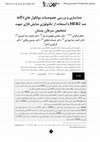
Abstract
Introduction
The scFvs (single-chain fragment variable) are popular recombinant antibo... more Abstract
Introduction
The scFvs (single-chain fragment variable) are popular recombinant antibody formats that are produced by advanced molecular biology and genetic engineering techniques. Moreover, HER2-ECD recognized as a suitable target for a wide range of cancer cells.
Materials and Methods
To isolate specific scFv fragments from phage library, phage display technology was carried out by coating HER2 extra cellular domain (HER2-ECD) protein onto an immuno tube. The resultant scFv antibodies were expressed in Escherichia coli TG1. The recombinant products were purified by metal affinity chromatography against His-tag. These scFvs were characterized for binding to HER2-ECD by western blot, biosensor surface resonance and flow cytometry assays.
Results
After three rounds of panning against HER2-ECD protein yielded three different scFv fragments that confirmed by subsequent DNA sequencing. The kinetic results indicated that all of isolated scFvs had binding tendency to HER2-ECD on micro molar to nano molar range. Western blot and flow cytometry results demonstrated that all of isolated scFvs have had binding tendency to HER2-ECD.
Conclusion
These results show that phage display is a powerful tool for isolate promising scFv clones that bind specifically to the HER2 receptor, a cell surface of breast cancer antigen.
Keywords: Biosensor, Flow cytometry, HER2 receptor, Antibody engineering, Phage display.
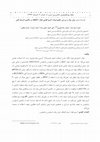
Phytase (myo-inositol hexakisphosphate) is the hydrolysis enzyme of phytic acid that produces ino... more Phytase (myo-inositol hexakisphosphate) is the hydrolysis enzyme of phytic acid that produces inorganic phosphate. The gene phyC encoding phytase was isolated from Bacillus subtilis ATCC12711 genomic library and sequenced. The nucleotide sequence of the phytase gene contained an open reading frame of 1089 bp, which codes for 90 bp signal peptide and a mature protein with a deduced molecular mass of 42 kDa. Target gene was inserted in pET32a (+) as expression vector and transformed to Escherichia coli BL21 (DE3) as host expression. The fusion phytase phyC-Trx gene was successfully overexpressed in E. coli as an active and cytoplasmic phytase. Recombinant protein production was induced with 1mM IPTG in shaking flasks at 30 0 C in presence of 10 mM calcium. Samples were taken at 0-5 h after induction by 1 hour time intervals, and then protein electrophoresis was done. phyC-Trx protein was expressed in the cytoplasm of E. coli successfully. Molecular weight of recombinant phytas was estimated about 64 kDa. Phytase activity was 7.44 U/ml with using standard phosphates method. Optimum pH for the degradation of phytate was 7. The results of current study showed that thermal stability and cost effective production make this enzyme attractive for using in feed supplements.
) دوره 4 ﺷﻤﺎره ، 1 ، ﺗﺎﺑﺴﺘﺎن و ﺑﻬﺎر 1391 ( ١٩ ﮐﻠﻮﻧﯿﻨﮓ، ﻣﻠﮑﻮﻟﯽ ﺧﺼﻮﺻﯿﺎت ﺑﺮرﺳﯽ ﭘﯿ... more ) دوره 4 ﺷﻤﺎره ، 1 ، ﺗﺎﺑﺴﺘﺎن و ﺑﻬﺎر 1391 ( ١٩ ﮐﻠﻮﻧﯿﻨﮓ، ﻣﻠﮑﻮﻟﯽ ﺧﺼﻮﺻﯿﺎت ﺑﺮرﺳﯽ ﭘﯿﺶ و ﻣﺠﺎزي ﺑﯿﺎن ﺑﯿﻨﯽ ﻓﯿﺘﺎز ژن phyC از ﺳﺎﺑﺘﯿﻠﯿﺲ ﺑﺎﺳﯿﻠﻮس ﻧﮋاد آرﯾﺎن ﺣﻤﯿﺪ 1 ﻧﺼﯿﺮي رﺿﺎ ﻣﺤﻤﺪ ، 2 و 3 ﻧﮋاد اﺳﻠﻤﯽ اﺻﻐﺮ ﻋﻠﯽ ، 4 ﭘﻮر ﻃﻬﻤﻮرث ﻣﺠﺘﺒﯽ ، 5 ، زاده وﻟﯽ رﺿﺎ 6 ، اﺣﻤﺪ آﺳﻮده 7 Email:
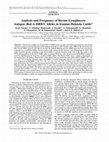
The bovine lymphocyte antigen (BoLA-DRB3) gene encodes cell surface glycoproteins that initiate i... more The bovine lymphocyte antigen (BoLA-DRB3) gene encodes cell surface glycoproteins that initiate immune response by presenting processed antigenic peptides to CD4 T helper cells. DRB3 is the most polymorphic bovine MHC class II gene which encodes the peptide-binding groove. DRB3 gene has been extensively evaluated as a candidate marker for association with various bovine diseases and immunological traits. This study describes genetic variability in the BoLA-DRB3 in Iranian Holstein cattle. This is the first study of the DNA polymorphism of the BoLA-DRB3 gene in Iranian Holstein cattle. Hemi-nested PCR-RFLP method is used for identification the frequency of BoLA-DRB3 alleles. The BoLA-DRB3 locus is highly polymorphic in the studied herd (26 alleles). Almost 67% of the alleles were accounted for four alleles *24, in Iranian Holstein cattle. The DRB3.2*8 allele frequency (26.6%) was higher than the others. The frequencies of the DRB3.2*54, *37, *36, *28, *25, *14, *13, *10, *1 alleles were lower than 1%. Significant distinctions have been found between Iranian Holstein cattle and other cattle breeds studied. In Iranian Holstein cattle the alleles ( BoLA-DRB3.2*22, *2, and *16 ) associated with a lower risk of cystic ovarian disease in Holstein cattle are found. The alleles associated with the resistance to mastitis and to bovine leukemia virus infection BoLA-DRB3.2*11 and *23 are detected with the frequencies 10.4 and 4.4%, respectively. Thus, in the Iranian Holstein cows studied alleles associated with resistance to various diseases are found. The method of DNA-typing of animals can be used in agricultural practice for BoLA-DRB3 allele genotyping of cattle in order to reduce spreading of alleles providing susceptibility to mastitis or leukemia in cattle herds.
Background: Mycobacterium (M.) bovis is the agent of bovine tuberculosis (TB) in a range of anima... more Background: Mycobacterium (M.) bovis is the agent of bovine tuberculosis (TB) in a range of animal species, including humans. Recent advances in immunology and the molecular biology of Mycobacterium have allowed identification of a large number of antigens with the potential for the development of a new TB vaccine. The ESAT-6 and CFP-10 proteins of M. bovis are important structural and functional proteins known to be important immunogens.
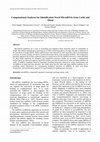
MicroRNAs (miRNA) are a class of noncoding and regulatory RNA molecules about 22 nucleotides in l... more MicroRNAs (miRNA) are a class of noncoding and regulatory RNA molecules about 22 nucleotides in length. MicroRNAs regulate gene expression by an RNA interfering pathway through cleavage or inhibition of the translation of target mRNA. Many miRNAs have been reported for their important roles in developmental processes in various animals, but there is limited information about cattle and sheep miRNAs. The comparative genomics approach due to their conserved nature is a good source for the miRNAs discovery. Cattle and sheep are ideal model organisms for biological and comparative genomics studies. In our study, a computational method based on expressed sequence tag (EST) analysis was used for detection of cattle and sheep miRNAs. In cattle, 25 miRNA candidates found by homology searching frequently clustered at certain chromosomes and 28 miRNAs in sheep had been detected. Our results show that the cattle and sheep miRNA database can be providing useful information for investigating biological functions of miRNAs in cattle and sheep. Furthermore, the bioinformatics approach is a good manner for studying these functions.
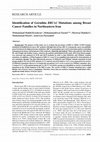
Background: The purpose of this study was to evaluate the prevalence of BRCA1 (MIM: 113705) found... more Background: The purpose of this study was to evaluate the prevalence of BRCA1 (MIM: 113705) founder mutations in familial breast cancer (BC) patients with high risks in Iran. BRCA1 is among the cancer susceptibility genes best known for high penetrance mutations. BRCA1 genotyping is now used to determine patient counseling, management decisions, and prognosis of this syndrome. Materials and Method: Thirty nine patients with clinical BC and 29 high risk healthy women, related to the patients, participated in the study. DNA from blood samples was extracted and analyzed by PCR and SSCP methods in order to find 185delAG and 5382insC founder mutations. In addition, a 251bp fragment of BRCA1's exon 11 was amplified and analyzed for determination of new mutations. Results: The data indicated the presence of 185delAG and 5382insC founder mutations in both groups studied. Two out of 39 BC patients (5.1%) and one out of 29 relatives (3.4%) were suspected to be carriers of 185delAG mutations. However, we found only one patient (2.6%) to be a carrier of a 5382insC mutation. Also, 2 women (5.1%) of the patient group and 3 n (10.3%) of relatives group were identified as carriers of unclarified mutations in the 251bp fragment of the BRCA1 gene. The carriers of BRCA1 founder mutations have a high lifetime risk of breast cancer. Conclusions: Therefore, these data are useful in counseling of individuals with a significant family history of breast cancer.
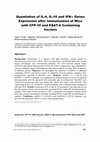
Background: Tuberculosis is a disease with high morbidity, caused mainly by Mycobaterium tubercul... more Background: Tuberculosis is a disease with high morbidity, caused mainly by Mycobaterium tuberculosis (M.tb.). DNA vaccines show a promising future due to their unique advantages over conventional methods. The early-secreted antigen target (ESAT)-6 and culture filtrate protein (CFP)-10 of M.tb. antigens have been identified as vaccine candidates against Mycobacteria and used as subunit vaccines, DNA or protein, in different studies. Objective: To investigate the potential of pcDNA3.1+ plasmid containing CFP-10 and ESAT-6 genes in induction of local immune responses after intramuscular injection in BALB/c mice. Methods: pcDNA 3.1+ CFP-10 and pcDNA3.1+ ESAT-6 plasmids were prepared and defined groups of mice were injected intramuscularly with the plasmids both separately and in combination. The RNA was extracted from muscles after one month and cDNA was made using RT-PCR. The expressions of IL-4, IL-10 and IFN-γ genes cytokines were evaluated using comparative real time PCR. Results: Expression of IL-4 and IL-10 increased in the injection site of the mice groups which received plasmids encoding ESAT-6 and CFP-10 individually or together. More than 10-fold increase in IFN-γ expression was found in samples taken from mice groups inoculated by plasmids encoding ESAT-6 and CFP-10 individually or together. Conclusion: pcDNA 3.1+ESAT-6 and pcDNA3.1+CFP-10 plasmids can increase the expression of IFN-γ in mice after immunization. Torabi A, et al. Iran J Immunol. 2013; 10(4):205-215
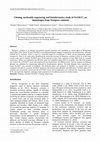
Neospora caninum is an obligate intracellular parasitic protozoa and considered as causal agent o... more Neospora caninum is an obligate intracellular parasitic protozoa and considered as causal agent of Neosporosis which infect wide variety of hosts. NcGRA7 is an immunodominant antigen recognized by sera from bovines, naturally infected by N. caninum, which is used as a powerful target for recombinant or DNA vaccine preparation against neosporosis. There is no study about identifying the molecular structure of Neospora caninum in Iran, so as first step, current study tried to identify NcGRA7 gene in this parasite in Iran. After extraction of total RNA from N. caninum tachyzoites, cDNA was synthesized and NcGRA7 gene was amplified using cDNA as template. Then the PCR product was cloned into pTZ57R/T vector and transformed into Escherichia coli (DH5α strain), and the resulted recombinant plasmid was submitted for sequencing, followed by bioinformatics analysis. The data obtained from sequencing of native NcGRA7 was recorded in GenBank. The deduced amino acid sequence of NcGRA7 in current study was compared with other N. caninum NcGRA7 sequences and showed some identities and differences. NcGRA7 gene of N. caninum was successfully cloned into the pTZ57R/T vector and recombination was confirmed by sequencing, colony PCR, and enzymatic digestion, making it ready expression of recombinant protein for further studies.
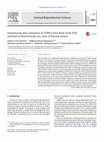
Flow cytometry is a widely used application for validating the accuracy of sperm sexing. However,... more Flow cytometry is a widely used application for validating the accuracy of sperm sexing. However, this method is relatively expensive and requires considerable technical support. An alternative method employing simpler technology at low cost could be suitable for the evaluation of bovine semen in laboratories with low budgets. We used a SYBR Green Real-Time PCR assay to determinate sex ratio in bovine semen. The PLP and SRY genes were amplified to isolate the specific fragments of X-and Y-chromosome sequences, respectively. Two certified standard curves were obtained using two plasmids containing PLP and SRY amplicons. Our results show no significant difference in semen sex ratio in unsorted semen (54.7 ± 0.52% X and 47.6 ± 0.60% Y). However, significant difference was observed in X/Ysorted semen (93.3 ± 0.08% X and 91.4 ± 0.06% Y-sperm), as compared to the expected ratio in unsorted semen or the post-sorting reanalysis data. The evolution of X-chromosome bearing sperm content in unsorted samples showed an average of 52.6 for ejaculates and 51.8 for the commercial semen. In order to confirm our results, the accuracy, repeatability and reproducibility of the method were tested resulting in 98.2% accuracy, repeatability of CV = 5.59% and reproducibility of CV = 5.40%. Thus, this method is demonstrated to be a reliable and inexpensive way to test sexual chromosome content in semen samples.
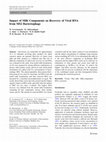
Noroviruses are responsible for approximately 44 % of outbreaks involving dairy products for whic... more Noroviruses are responsible for approximately 44 % of outbreaks involving dairy products for which causative agents are reported. Recovery of viruses from milk and dairy products is a difficult task. The role of different components of milk in the recovery of viral RNA was evaluated in this study. Four model milk formulations (A-D) were prepared by mixing different combinations of lactose, whey protein, casein, and fat in water. Each model formulation was spiked with five concentrations of bacteriophage MS2. The phenol-guanidine thiocyanate-chloroform protocol was used for extracting viral RNA from the model milk formulations and then extracted RNA was measured by a nanodrop spectrophotometer in ng/ll. The results showed that casein and whey protein had the highest negative impact on RNA yield, especially when the number of MS2 was less than 1.3 pfu/ml. The highest RNA recovery was obtained from the model milk formulation containing all four components; lactose, whey protein, casein, and fat. The amount of extracted RNA was closely correlated with the dry matter content of each formulation and the spiked concentration of coliphage using response surface modeling (R 2 :0.93). It was determined that milk fat is the most effective component in facilitating RNA extraction and the highest RNA yield can be achieved via elimination of whey protein and casein from milk by centrifugation at 40,0009g for 60 min. To achieve the highest viral RNA recovery efficiency by the proposed method, milk fat must be recombined with the supernatant of the centrifuged sample and then homogenized before performing the extraction protocol.
This study has implication on Biotechnology researchers.
κ-casein is a glycosilated protein belonging to a family of phosphoproteins (αs1,β, αs2,κ) that r... more κ-casein is a glycosilated protein belonging to a family of phosphoproteins (αs1,β, αs2,κ) that represents the major protein component in mammalian milk. κ-casein plays an essential role in the case of micelle stabilization, determining the size and the specific biological function. In the present study, we report the characterization of the partial sequence of κ-casein promoter region in the Iranian Bacterianus and Dromedaries camels. κ-casein partial promoter fragment (1212 bp) was successfully amplified, and sequenced. The sequence analysis results showed that there was a high homology (>95%) in the region of sequenced camel partial promoter fragment and related sequences in the vast range of species. Furthermore, four and three haplotypes observed in Bacterianus and Dromedaries camels, respectively.
Objective: The aim of present study was cloning and expression of phiC31 integrase cDNA in a bact... more Objective: The aim of present study was cloning and expression of phiC31 integrase cDNA in a bacterial expression vector. Thus, an intra molecular assay vector was applied to show in vitro activity of recombinant protein.
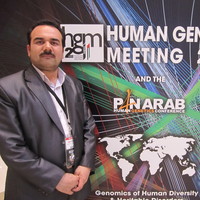







Uploads
Books by Mohammadreza Nassiri
Papers by Mohammadreza Nassiri
Introduction
The scFvs (single-chain fragment variable) are popular recombinant antibody formats that are produced by advanced molecular biology and genetic engineering techniques. Moreover, HER2-ECD recognized as a suitable target for a wide range of cancer cells.
Materials and Methods
To isolate specific scFv fragments from phage library, phage display technology was carried out by coating HER2 extra cellular domain (HER2-ECD) protein onto an immuno tube. The resultant scFv antibodies were expressed in Escherichia coli TG1. The recombinant products were purified by metal affinity chromatography against His-tag. These scFvs were characterized for binding to HER2-ECD by western blot, biosensor surface resonance and flow cytometry assays.
Results
After three rounds of panning against HER2-ECD protein yielded three different scFv fragments that confirmed by subsequent DNA sequencing. The kinetic results indicated that all of isolated scFvs had binding tendency to HER2-ECD on micro molar to nano molar range. Western blot and flow cytometry results demonstrated that all of isolated scFvs have had binding tendency to HER2-ECD.
Conclusion
These results show that phage display is a powerful tool for isolate promising scFv clones that bind specifically to the HER2 receptor, a cell surface of breast cancer antigen.
Keywords: Biosensor, Flow cytometry, HER2 receptor, Antibody engineering, Phage display.
Introduction
The scFvs (single-chain fragment variable) are popular recombinant antibody formats that are produced by advanced molecular biology and genetic engineering techniques. Moreover, HER2-ECD recognized as a suitable target for a wide range of cancer cells.
Materials and Methods
To isolate specific scFv fragments from phage library, phage display technology was carried out by coating HER2 extra cellular domain (HER2-ECD) protein onto an immuno tube. The resultant scFv antibodies were expressed in Escherichia coli TG1. The recombinant products were purified by metal affinity chromatography against His-tag. These scFvs were characterized for binding to HER2-ECD by western blot, biosensor surface resonance and flow cytometry assays.
Results
After three rounds of panning against HER2-ECD protein yielded three different scFv fragments that confirmed by subsequent DNA sequencing. The kinetic results indicated that all of isolated scFvs had binding tendency to HER2-ECD on micro molar to nano molar range. Western blot and flow cytometry results demonstrated that all of isolated scFvs have had binding tendency to HER2-ECD.
Conclusion
These results show that phage display is a powerful tool for isolate promising scFv clones that bind specifically to the HER2 receptor, a cell surface of breast cancer antigen.
Keywords: Biosensor, Flow cytometry, HER2 receptor, Antibody engineering, Phage display.